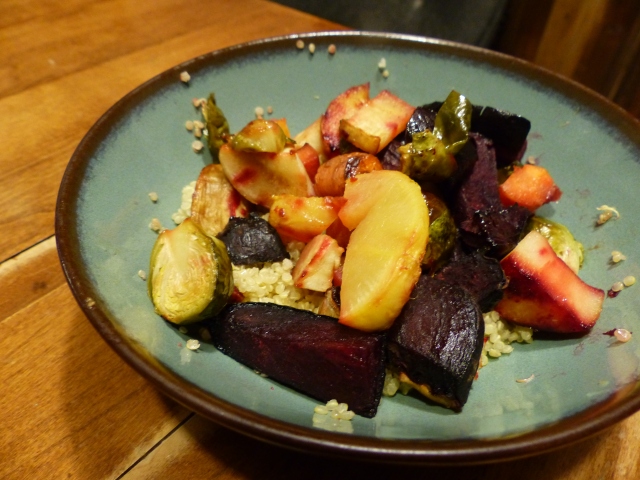
In Traditional East Asian Medicine our bodies are a microcosm of the natural world. Each organ system is related to a season, an aspect of nature, a cognitive function, a body tissue, and an emotion. March marks the beginning of spring and the season of the Liver and Gallbladder in East Asian Medicine.
The Liver and Gallbladder in East Asian medicine represent a larger idea than the organs with those names. They represent a meridian, or a channel that traverses the outside of the body and goes internally to connect with different organs and body structures. For instance, the Liver meridian goes from the inside edge of your big toe, up your inner leg, onto your abdomen, and then shifts internally below your sixth rib. The internal channel curves around the stomach, travels through the liver, lung, throat, and ends at the very top of your head. Movement of energy along the Liver/Gallbladder meridians is important for the functions listed below.
The Liver and the Gallbladder are a dynamic duo. Along with their springtime affiliation, they are noted to bring the body vigor and life force, like new foliage bursting forth out of the ground. Think of crocuses punching through the frosty earth. Not surprisingly, the Liver and Gallbladder are linked to the natural element of ‘wood,’ meaning plant life. In health, plants grow persistently towards the light, are limber and flexible enough to survive windstorms, and are adaptive. In human behavior, the wood element represents planning, decision-making, strategizing, and bringing ideas into fruition. The orifice of the liver is said to be the eyes, where it can look out at the horizon and plan accordingly to encounter events seen off in the distance. Joints and any part of the body that pivots are governed by the Liver/Gallbladder, as pivoting allows you to take in all horizons at once.
 The emotion associated with the Liver/Gallbladder duo is anger. Anger gets a bad rap, but has a healthy manifestation. The healthy expression of anger is the type of anger that fueled the civil rights movement and women’s suffrage. In this light, the Liver and Gallbladder have a strong relationship to justice.
The emotion associated with the Liver/Gallbladder duo is anger. Anger gets a bad rap, but has a healthy manifestation. The healthy expression of anger is the type of anger that fueled the civil rights movement and women’s suffrage. In this light, the Liver and Gallbladder have a strong relationship to justice.
The body tissues of the Liver/Gallbladder pair are the tendons, ligaments, and connective tissues. The energy of the Liver also makes sure the blood vessels are clear to provide smooth circulation of blood throughout the body. In this way, the liver is in charge of making sure the connective tissues get adequate nourishment. If this process is hindered in anyway, our tendons can become dry and brittle like a desiccated tree that can easily break.
When the Liver meridian and organ are not functioning optimally, certain emotions tend to occur. If the liver meridian still has too much oomph to it, the more energetic emotions of unhealthy anger, rage, and frustration will begin to occur, and can slowly increase in frequency until health returns to the Liver meridian. If, on the other hand, the Liver meridian is lacking energy, then depression and apathy set in. These emotions are often one of the first signs that the Liver meridian is not functioning optimally. Other signs include: pain along the Liver and Gallbladder meridian, difficulty making decisions, pain in our joints, insomnia, stressful dreams, and easily injured tendons and ligaments. These are all signs that your body needs a little help getting back on track and, in the springtime, the liver/gallbladder energy can be particularly feisty. Certain foods and flavors can help mitigate these symptoms.
 The flavor that soothes a cranky Liver/Gallbladder is sweetness. This is often why we crave sweets when stressed. The sweetness that soothes is the sweetness of grains, root vegetables, and mild fruits. Refined sugar in pastries and candies will actually make everything worse after a brief moment of bliss.
The flavor that soothes a cranky Liver/Gallbladder is sweetness. This is often why we crave sweets when stressed. The sweetness that soothes is the sweetness of grains, root vegetables, and mild fruits. Refined sugar in pastries and candies will actually make everything worse after a brief moment of bliss.
The sour flavor is the flavor of the Liver meridian and small amounts of sour can help move some gentle irritation or a feeling of being ‘stuck.’ Use the sour flavor sparingly in the spring, because too much can act detrimentally during this season.
One of the best recipes for someone suffering from being easily irritable or even exploding into a rage is Borscht. The beets have the perfect sweetness to soothe the liver, and adding a dollop of sour cream adds a hint of sour. If you cook it the traditional way with beef broth, the minerals aid in keeping the quality of your blood strong, thus nourishing your tendons and ligaments. Borscht is a favorite Eastern European dish and googling a recipe can get you many delightful arguments of what is the traditional recipe.
Below is a spunky borscht recipe. It is vegetarian and to make it for an omnivore I would cook everything in beef stock or broth and sometimes add a good sausage or a pound of beef stew meat. I also always use a small cabbage shredded into the soup. You can quickly see how an authentic recipe sparks arguments.
vegetarian borscht recipe
Two tasty greens recipes for a happy liver
 It is also thought that greens help support the function of the liver and the gallbladder. They can help out tendon flexibility (via the Liver and Gallbladder), and help support your blood volume. Here is one of the delightful overlapping of Chinese medicinal understand of blood and Western physiology match up. The dark, leafy greens of Chard, Collards, and Kale all contain a hefty dose of vitamin B12 and folic acid. These nutrients are necessary for blood cells to divide properly and regenerate, which directly relates blood volume. An deficiency in B12 and folic acid results in one type of anemia that many people suffer from.
It is also thought that greens help support the function of the liver and the gallbladder. They can help out tendon flexibility (via the Liver and Gallbladder), and help support your blood volume. Here is one of the delightful overlapping of Chinese medicinal understand of blood and Western physiology match up. The dark, leafy greens of Chard, Collards, and Kale all contain a hefty dose of vitamin B12 and folic acid. These nutrients are necessary for blood cells to divide properly and regenerate, which directly relates blood volume. An deficiency in B12 and folic acid results in one type of anemia that many people suffer from.
Now for the first quick recipe:
Quick and Easy Greens: Option One
1 bunch of swiss chard, collards or kale
1-2 Tablespoons balsamic vinegar
2-4 cloves of garlic (depending on how Italian you feel)
2 T olive oil
Pepper to taste (salt optional).
Before cooking, thoroughly wash the greens. Roughly chop them into 1-2 inch ribbons. If you feel strongly about dispatching the stems, then cut down the center, along each side of the stem and discard it before chopping the tender leafy parts. In a cast iron skillet, heat the olive oil and garlic. Once warm, add the greens and cook until wilted, about 1 minute for chard, and 2-3 minutes for collards or kale. Add the balsamic vinegar and pepper. Remove from heat and you have a delicious side ready to go.
Quick and Easy greens, option 2.
1 bunch greens, swiss chard, collards or kale
1 lemon
2 T olive oil
2-4 cloves garlic
1 tsp crushed black pepper
a pinch of salt
Thoroughly wash the greens. Roughly chop into 2 inch segments and place into a stove-top steamer. Bring the water to a boil, and thus steam. It should take about 10 minutes from the time you put the greens into the cold steamer to when they have been thoroughly steamed.
In the meantime, find a mixing bowl that it is large enough to toss the steamed greens about in when they are finished. Mince the garlic cloves and toss them in the bowl. Add the olive oil. Cut the lemon in half and squeeze the juice of both halves into the bowl. Add the pepper and a pinch of salt. Whisk it all together.
When the greens have finished steaming, give them a good solid toss in the dressing and your ready to eat.



Reblogged this on Stick Out Your Tongue.
LikeLike
Reblogged this on Albany Acupuncture Health Center and commented:
Take a look at this explanation of how the Liver channel relates to the spring season, good stuff. Also has some excellent greens recipes at the end.
LikeLiked by 1 person
I love the recipes at the end, thanks.
LikeLiked by 1 person